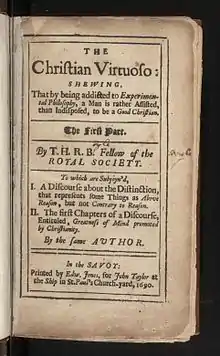The Christian Virtuoso
The Christian Virtuoso (1690) was one of the last books published by Robert Boyle,[1] who was a champion of his Anglican faith. This book summarised his religious views[2] including his idea of a clock-work universe created by God.[3][4] Boyle was a devout Anglican, and with the rise of science and reason during his lifetime, was troubled by increasing atheism. This spurred him to write about his belief of science and religion supporting each other.[5]

Contents
On this book's title page (see picture) Boyle states "that, being addicted to experimental philosophy a man is rather assisted than indisposed to be a good Christian." And this principle is what he sets out to show.[6] The Christian Virtuoso summarized Boyle's views that the study of God's handiwork was a religious duty and that by studying God's handiwork, God's goodness and overarching existence would be illuminated. Some see The Christian Virtuoso as a manifesto of Boyle's life as the ideal Christian scientist. [5]
John Locke's review
John Locke read and reviewed a manuscript of the book in 1681.[7]
Meaning of the word virtuoso
In the early 17th century the word virtuoso first referred to a gentleman interested in precious stones and antiquities. In the title Boyle equates a natural philosopher (later to be called a scientist) with a virtuoso, which by the middle of 17th century had already begun to take on this meaning.[8]
Its influence
This book was in part the basis for Cotton Mather's 1721 book The Christian Philosopher.[8]
Boyle's religious views
The historian and Oxford University Science and Religion theologian John Hedley Brooke has pointed out that one of many ironies in the history of religion and science interactions is that while the 17th century Boyle used the idea of a clock-work universe "to affirm God's sovereignty," 18th century deists would use the same clock-work image "to attack established religion." [9] Boyle saw scientific inquiry as a form of religious worship; a view shared by other 17th century scientific figures such as John Ray. Explicit in Boyle's writings are the images of nature as temple and the scientist as priest.[10]
Besides The Christian Virtuoso, Boyle also wrote at least three other works championing his Christian faith. These were Of the high Veneration Man's Intellect owes to God, peculiar for his Wisdom and Power (1684), Discourse Of Things Above Reason, inquiring whether a Philosopher should admit there are any such (1681), and Some Considerations touching the Style of the Holy Scriptures (1661). An 1835 book[11] by Henry Rogers is a collection of these works.
See also
References
- Religion, Reason and Nature in Early Modern Europe, Robert Crocker, Springer, 2001 ISBN 1-4020-0047-2 pp. 97–116
- 'Theological activities', "Boyle, Robert." Encyclopædia Britannica. 2008. Encyclopædia Britannica Online Library Edition. 3 Sept. 2008
- The Philosophy of Robert Boyle Peter R. Anstey, Published by Routledge, 2000, ISBN 0-415-22429-2
- The Sceptical Chymist and the Christian Virtouso
- Principe, Lawrence. "Robert Boyle". www.britannica.com. Encyclopædia Britannica. Retrieved 9 December 2014.
- Religious Thought in England, from the Reformation to the End of Last Century A Contribution to the History of Theology by John Hunt, 1871
- "THE CHRISTIAN VIRTUOSO AND JOHN LOCKE by Peter Anstey". Retrieved 10 September 2008.
- Mather, Cotton (2000). The Christian Philosopher By Cotton Mather, Winton U. Solberg University of Illinois Press, 2000 ISBN 0-252-06893-9. ISBN 9780252068935. Retrieved 10 September 2008.
- John Hedley Brooke, "Introduction" (pages 1–14) to Science and Religion: Some Historical Perspectives, 1991, Cambridge University Press, ISBN 0-521-23961-3, page 13
- John Hedley Brooke, Science and Religion: Some Historical Perspectives, 1991, Cambridge University Press, ISBN 0-521-23961-3, page 18
- Hon. Robert Boyle (1835). Treatises on the high veneration man's intellect owes to God: on things above reason: and on the style of the holy Scriptures. With an intr. essay, by H. Rogers. Retrieved 18 June 2012.
Further reading
- The Christian Virtuoso 1690 edition
- Robert Boyle and the Limits of Reason Jan W. Wojcik, Cambridge University Press, 2002, ISBN 0-521-52522-5, 261 pages
- Robert Boyle, 1627–91 Michael Hunter, Boydell & Brewer, 2000, ISBN 0-85115-798-X, 293 pages
- The Aspiring Adept: Robert Boyle and His Alchemical Quest, Lawrence M. Principe, Princeton University Press, 2000, ISBN 0-691-05082-1, 340 pages
- Robert Boyle: A Study in Science and Christian Belief Reijer Hooykaas, University Press of America, 1997, ISBN 0-7618-0708-X, 131 pages
- Robert Boyle Reconsidered, Michael Hunter, Cambridge University Press, 1997, ISBN 0-521-89267-8, 249 pages
- Religious Origins of Modern Science, Eugene Marion Klaaren, Eerdmans, 1977, ISBN 0-8028-1683-5, 244 pages
